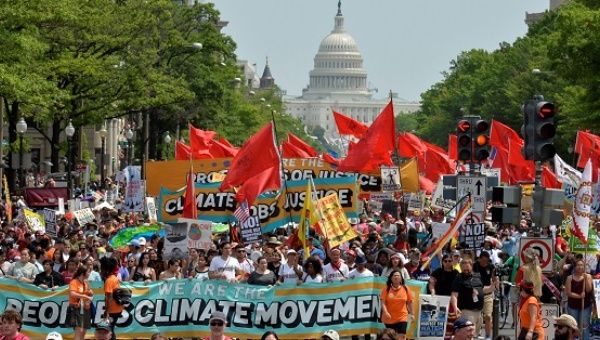We drove from Carlisle down through Adams County toward the capital, up and down the ribbon-candy hills of Route 94, past green fields, dips and rises, orchards swelling into bloom, barns and homes, a stretch of country that wanted us all to believe in growth and peace.
I was tired. The weather was steamy. 90s, with a humid haze over the horizon. The DC asphalt shone. It had been a long semester, a long year. Years? I went to the first People’s Climate March two years ago, in 2014 in New York. I remember the moment of silence, echoing among the skyscrapers, and the collective roar just after. Hundreds of thousands of us were in the streets.
That was before the 2016 elections, before the inauguration of a president who called climate change a hoax, the appointment of an EPA administrator who has taken hundreds of thousands of dollars from fossil-fuel companies, the issuance of an executive order aimed to roll back the Clean Power Plan. Dozens of similar news items.
Now hundreds of thousands of us were, again, in the streets.
I’m not a climate scientist or an environmental activist or an activist of any kind. I teach and write about food sometimes, which means that I think about sustainability and the environment a lot. But mostly I think about these things as an ordinary citizen trying to do and know the bare minimum of citizenly things. Which has meant, since January, reading a lot more news, scanning a lot more government websites, making a lot more phone calls, signing a lot more petitions. Mailing postcards to government offices and going to meetings. Donating more. Striking. And demonstrating, demonstrating big and small—the Women’s March in Los Angeles, where some organizers claimed a half-million people, and a tax-day rally in Harrisburg, where the fervent were fewer than a hundred.
The People’s Climate March was definitely big. I saw protestors from New York and South Dakota and British Columbia. I heard a few different languages. There were giant puppets and floats, costumes and kooky hats, and bands and choruses. There were all sorts of signs and slogans. (I lost track of the number of posters depicting Mar-a-Lago falling into the sea.) I took my place among the crowd. I marched, I shouted against fossil fuels and for democracy, against environmental racism and for climate justice. I chanted shame shame shame, in rhythm with others, as I passed the Trump International Hotel.
Still, my heart wasn’t in it. Even my shallow, silly efforts had left me tired. When it came time for the moment of silence, this march, we were all supposed to sit down. I didn’t want to get up.
I was tired of the bluntness of what was so obviously necessary, of the repetition so clearly needed. Of the feeling that we—my country? species? world?—are slipping backwards, undoing what has been done and re-doing what shouldn’t have to be.
Which is one more explosion of a misconception I keep having to chide. Teaching in the humanities has taught me how difficult it is to shake visions of progress that put my own time at the end of a steady upward arrow. Certainly, I know that history and culture is punctuated by darkness, evil, cataclysm. But it’s so tempting, even still, to think that attitudes shift fairly steadily toward a more just and nurturing world. Tempting for my students and tempting for me—maybe tempting for most? Think of all those social-media posts, for example, that link to something horrific and comment only “in 2017” or something like.
Yes, in 2017. Yes, now. Yes, again or still. The more I learn about history and literature, the more I see instances of backward slides, visions of economic justice from the fourteenth century or environmental care from the eighteenth or racial equality from the nineteenth or twentieth that were snuffed out, in various ways, and haven’t yet been reached again.
Which cautions us that anything good can be undone—reversed. But that lots of good things are possible?
A popular self-help bromide defines insanity as “doing the same thing over and over again and expecting a different result.” This sentence would be basically wrong, I think, even if it were not annoyingly smug. At how many times in the past am I grateful that activists and organizers and citizens did exactly that? At how many times in the future will I be grateful that people around me now did, too?
We don’t always know in what direction we’re heading. We don’t always know what our actions will mean. Even, maybe, to ourselves.
We don’t always know who we’re marching with, or toward. [Note: After putting down these impressions I learned that this idea is a key argument in Rebecca Solnit’s Hope in the Dark, recommended to me by one of the friends I marched with in DC. Another reason to go to marches is to get recommendations like this one. Read Solnit for more.]
My group of marchers peeled off from the route a bit early. The friends that kindly gave me a ride included a baby and school-age kid, and we were all feeling the heat. We turned from the cacophony on Pennsylvania Avenue to the empty expanse of Constitution, aiming to cut across, via Louisiana, to the parking garage. And there was the Capitol Building, all of a sudden, quietly watching.

